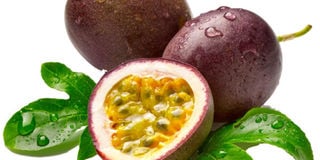Passion fruits

Please educate me on passion fruit farming.
Cornel Rono
Dear Cornel
Passion fruit is a perennial climbing vine that enjoys both good domestic and export markets.
The fruit may be eaten fresh or consumed after extracting the pulp and juice, which are used in a variety of products.
A wide range of cosmetic products and food flavours are derived from the fruit. Passion fruit is rich in vitamins A and C and carotene, making it an important health food.
Varieties
We have yellow and purple types. Purple varieties do better at higher altitudes than the yellow types, which tend to yield higher and are more resistant to diseases.
The purple variety is very acidic, variable in taste and juiciness with intense aromatic scent and round in shape.
The yellow variety is bigger, with similar taste but possibly less aromatic, more acidic and round in shape.
Both varieties are green before ripening. Yellow passion fruits are most widely grown for commercial purposes globally.
Ecological requirements
Temperature: The optimum temperature for purple passion fruit is between 18°C to 25°C and 25°C to 30°C for yellow variety.
Rainfall: The plant needs well-distributed rainfall of 900mm to 2,000mm per year. Excess rainfall causes poor fruit set and encourages diseases.
Soils: Passion fruits do well in a variety of soils, which should be reasonably deep and fertile. A soil pH of 6.0 to 6.5 is the best.
In high rainfall areas, the soils should be well-drained, as plants will not withstand water-logging or flooding.
Planting and trellising
Passion fruit can be grown from seeds but grafting often produces improved stock. Yellow passion fruit is best for production of rootstock because of superior disease-resistance. Seeds are propagated after removal of the pulp and drying. Germination requires up to four weeks. Seedlings will require up to four months to reach a suitable transplanting growth stage.
After about seven weeks of growth following transplanting, each plant should have up to four healthy lateral stems. Transplanting should be done at the beginning of the rainy season. Passion fruit has deep roots, so soils should be well-tilled.
Have a fence to provide support or a wire trellis should be constructed. The vines are usually directed so that growth is in both directions along the supporting wires.
Yields are highest following a regular fertilisation regime. Old or dead shoots should be pruned. Intercropping with vegetables or other annuals is recommended.
Once established, the vines grow rapidly and the plant flowers after about seven months. Passion vines are planted 2m apart and in rows, 3m apart.
Horizontal trellises have cross-pieces at the top of each post with 2-4 wires strung horizontally 60cm apart along the top of each cross-piece.
Vertical trellises consist of heavy posts without cross-pieces, with two or three wires strung along the row like barbed wire fencing, attached to the posts from the top down at intervals about 30-40cm apart.
Trellis wires should be No. 9 or 10 galvanised steel and placed on stronger posts that can withstand the weight of the vines throughout a season.
Ideally, they should be long enough to provide a trellis height of 1.5m, with 45-75cm in the ground.
Trellis rows should be oriented north-south for maximum exposure to sunlight, and the vines should be allowed to grow together along the trellises to promote cross-pollination.
Fertiliser application
At planting, use 175g of Triple Super Phosphate (TSP) and one ‘debe’ (about 20 kilogrammes) of farmyard manure and mix well. To obtain high yields, regular fertilisation is necessary. Apply 300g of Calcium Ammonium Nitrate (CAN) per plant per year in two applications of 150g at each rainy season. Spraying with foliar feeds and trace elements is also recommended.
Crop protection
Weeding is essential when the plants are first transplanted. Disease is usually sufficiently controlled by crop rotation as plantations are not kept for more than three years. Infected plant material should be pruned and destroyed and vines kept as open as possible to allow thorough application of sprays.
Diseases can also be controlled by good management, better orchard hygiene, and a suitable spray programme.
Harvesting
The skin of the fruit is deep purple/yellow when ready for harvesting. Its pulpy interior is bright yellow, filled with small black seeds. For fresh market or use, the fruit is picked when colour changes occur. For processing, the fruit is allowed to drop to the ground and picked at least every second day when shrivelled.
Answered by Carol Mutua




